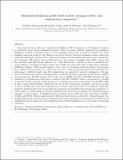Membrane distillation model based on heat exchanger theory and configuration comparison
Author(s)
Swaminathan, Jaichander; Chung, Hyung Won; Warsinger, David Elan Martin; Lienhard, John H
DownloadModule_Comparison_Efficiency_Theory-DSPACE.pdf (1.303Mb)
OPEN_ACCESS_POLICY
Open Access Policy
Creative Commons Attribution-Noncommercial-Share Alike
Terms of use
Metadata
Show full item recordAbstract
Improving the energy efficiency of membrane distillation (MD) is essential for its widespread adoption for renewable energy driven desalination systems. Here, an energy efficiency framework for membrane distillation modules is developed based on heat exchanger theory, and with this an accurate but vastly simplified numerical model for MD efficiency and flux is derived. This heat exchanger analogy shows that membrane distillation systems may be characterized using non-dimensional parameters from counter-flow heat exchanger (HX) theory such as effectiveness (εε) and number of transfer units (NTU). Along with the commonly used MD thermal efficiency (ηη), “MD effectiveness” ε should be used to understand the energy efficiency (measured as gained output ratio, GOR) and water vapor flux of single stage membrane distillation systems. GOR increases linearly with ηη (due to decreasing conduction losses), but increases more rapidly with an increase in εε (better heat recovery). Using the proposed theoretical framework, the performance of different single stage MD configurations is compared for seawater desalination. The gap between the membrane and the condensing surface constitutes the major resistance in both air gap (AGMD) and permeate gap (PGMD) systems (75% of the total in AGMD and 50% in PGMD). Reducing the gap resistance by increasing gap conductance (conductive gap MD (CGMD)), leads to an increase in εε through an increase in NTU, and only a small decrease in ηη, resulting in about two times higher overall GOR. GOR of direct contact MD (DCMD) is limited by the size of the external heat exchanger, and can be as high as that of CGMD only if the heat exchanger area is about 7 times larger than the membrane. While MD membrane design should focus on increasing the membrane’s permeability and reducing its conductance to achieve higher ηη, module design for seawater desalination should focus on increasing ε by reducing the major resistance to heat transfer. A simplified model to predict system GOR and water vapor flux of PGMD, CGMD and DCMD, without employing finite difference discretization, is presented. Computationally, the simplified HX model is several orders of magnitude faster than full numerical models and the results from the simplified model are within 11% of the results from more detailed simulations over a wide range of operating conditions.
Date issued
2016-10Department
Massachusetts Institute of Technology. Department of Mechanical Engineering; Rohsenow Kendall Heat Transfer Laboratory (Massachusetts Institute of Technology)Journal
Applied Energy
Publisher
Elsevier
Citation
Swaminathan, Jaichander, Hyung Won Chung, David M. Warsinger, and John H. Lienhard V. “Membrane Distillation Model Based on Heat Exchanger Theory and Configuration Comparison.” Applied Energy 184 (December 2016): 491-505.
Version: Author's final manuscript
ISSN
03062619